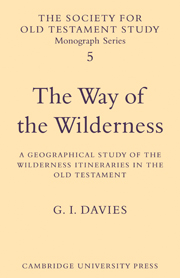Book contents
- Frontmatter
- Contents
- Preface
- Abbreviations
- Maps
- 1 Introduction
- 2 Jewish interpretations in Greek
- 3 Jewish interpretations in Hebrew and Aramaic
- 4 Christian interpretations
- 5 Arabic interpretations
- 6 Behind the traditions
- 7 Key points on the routes
- 8 Routes in the Sinai Peninsula
- 9 Identification of the routes described
- Notes to the text
- Bibliography and Author Index
- Indexes
6 - Behind the traditions
Published online by Cambridge University Press: 04 August 2010
- Frontmatter
- Contents
- Preface
- Abbreviations
- Maps
- 1 Introduction
- 2 Jewish interpretations in Greek
- 3 Jewish interpretations in Hebrew and Aramaic
- 4 Christian interpretations
- 5 Arabic interpretations
- 6 Behind the traditions
- 7 Key points on the routes
- 8 Routes in the Sinai Peninsula
- 9 Identification of the routes described
- Notes to the text
- Bibliography and Author Index
- Indexes
Summary
Since the discussion of early Jewish, Christian and Arabic tradition about the route of the Israelites has involved so much intricate examination of various literary sources, it may be helpful if, before proceeding further, we summarise our findings.
At the beginning of the history of the interpretation of the wilderness itineraries, so far as we can recover it, the Septuagint already indicates contemporary equivalents for places at the beginning of the journey. It equates Yam Suf with the Red Sea, and this remains basic for most later interpretations. The Antiquities of Josephus show how a more exact conception of the initial stages had emerged and how some important sites in the later part of the journey were beginning to be located, particularly in Transjordan. In Contra Apionem a markedly different tradition, which places the point of departure in the north-east of the Nile delta, appears, but there is nothing to suggest that Josephus took this to imply a divergent route further on. Elements in the Targumim which go back to the Tannaitic period or before presuppose the same northern point of departure and outline a route which passes into the desert east of Egypt and then reaches Mount Sinai in the south of the peninsula. Traditions in the Talmud and Midrash from the same period show that the final encampment in the plains of Moab was being pointed out to travellers, and imply a considerable interest in the location of other events in the wilderness narratives.
- Type
- Chapter
- Information
- The Way of the WildernessA Geographical Study of the Wilderness Itineraries in the Old Testament, pp. 56 - 61Publisher: Cambridge University PressPrint publication year: 1979



